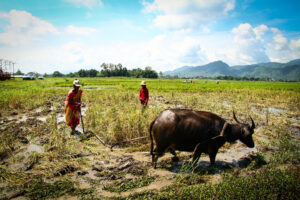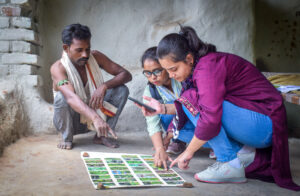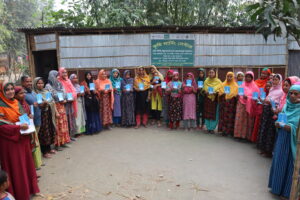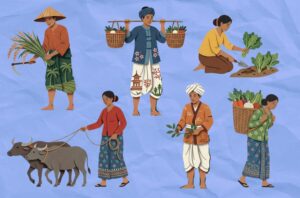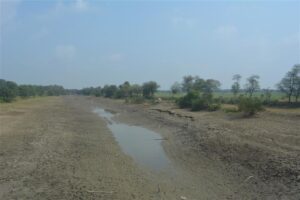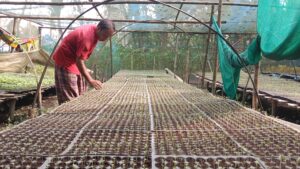By Sharif Ahmed, Humnath Bhandari
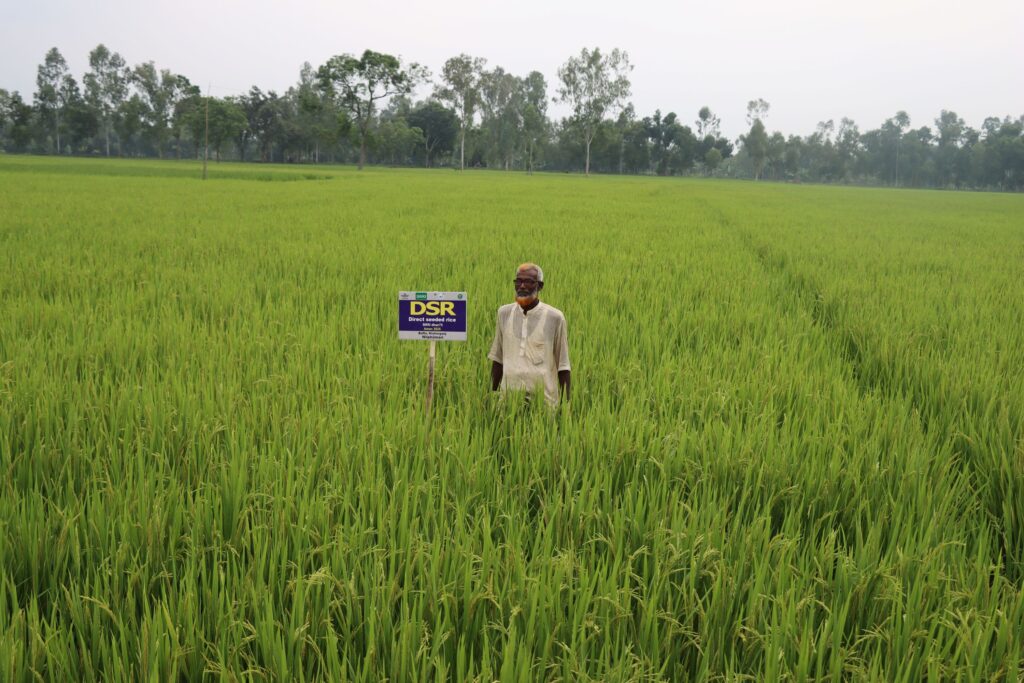
Rice covers 11% of the world’s arable land and is responsible for approximately 1.5% of global anthropogenic greenhouse gas (GHG) emissions and around 10-12% of total agricultural emissions.
Bangladesh is one of the most rice-dependent countries (cultivates ~75% of its arable land) in the world. This creates a dual challenge of ensuring food security for a growing population while minimizing environmental impacts. The country has extensive rice cultivation covering approximately 11.5 million hectares (production ~39 million tons), significantly contributing to GHG emissions. Rice cultivation is responsible for approximately 18-22% of the overall human-caused emissions, where the total agricultural emission, including livestock, is around 28-30%. In the agricultural sector, methane gas (CH4) is the major contributor to GHG emissions. Rice contributes around 62% of CH4, while the contribution of rice to agricultural nitrous oxide (N2O) emissions is around 11-13%.
In 2018, Bangladesh introduced its Nationally Determined Contributions (NDC) implementation roadmap and action plan, pledging to cut GHG emissions by 27.56 million tons of carbon dioxide (CO2) equivalent unconditionally, and by an additional 89.47 million tons conditionally, by 2030 compared to 2012 levels.
The total GHG emission of Bangladesh was estimated at 169.06 million tons in the base year, which is estimated to increase to around 409.41 million tons by 2030.
To tackle these emissions, the agricultural sector is looking at multiple strategies: reduction of emissions from rice fields, fertilizer use, enteric fermentation, and manure management. Among these, specific crop production strategies include upscaling Alternate Wetting and Drying in dry-season rice across approximately 150,000 hectares, rice varietal improvement for about 3.24 million hectares, and reducing nitrous oxide emissions from nitrogen-based fertilizer management to 836,000 hectares. Additionally, fertilizer management practices are being improved at 200,000 hectares, and efforts are being made to expand pulse cultivation to increase overall crop diversification.
Although Bangladesh contributes only a small share of global greenhouse gases, its rice sector has a disproportionate impact on methane emissions. Transitioning to low-carbon rice farming offers a path to sustainable agriculture, climate action, and improved livelihoods.
Alternate Wetting and Drying (AWD) irrigation systems
AWD is an effective water management technique where farmers can intermittently dry their rice fields, avoiding continuous flooding that significantly reduces water use and GHG emissions, particularly CH4, by inhibiting methane-producing bacteria. This practice increases water productivity and can reduce irrigation costs without compromising or even improving rice yields. Studies show that AWD can decrease water consumption in rice cultivation by up to 40% and reduce methane emissions by up to 50%, depending on conditions.
AWD was first introduced in Bangladesh in 2004 with the support of the International Rice Research Institute (IRRI), and the first trials were conducted by the Bangladesh Rice Research Institute (BRRI). Since the introduction, the adoption rate of AWD in Bangladesh has not been widespread. Adoption of AWD in Bangladesh is hampered due to various factors; the lack of economic incentives for farmers for water saving, as irrigation is often charged per area rather than volume; the lack of flexible irrigation controls; unreliable electricity for pumps; the high costs associated with managing increased weed growth that comes with the practice; chance of large soil cracks consequently requiring more water; no strong national policy; and insufficient knowledge among farmers about the technology’s full benefits and proper implementation.

Before the COP 21 climate conference in 2015, AWD was focused mainly on saving water. At this conference, participating countries committed to limiting global warming to below two degrees Celsius (2°C) above pre-industrial levels, with a preference for capping it at 1.5°C. This commitment involves reducing greenhouse gas emissions, adapting to the impacts of climate change, and increasing financial support for developing nations. During COP 21, countries were also encouraged to develop and submit their own NDCs for cutting emissions and to update these regularly to enhance their commitments. Thereafter, the AWD practice became recognized as a GHG mitigation tool, particularly for methane.
Bangladesh has already committed to its NCD to upscaling AWD in dry-season rice across approximately 150,000 hectares of land. But to date, the adoption rate has been low due to the aforementioned reasons. Suggestions for overcoming adoption barriers include:
- Suitability mapping is essential for identifying areas where AWD is feasible and effective. While Aman (wet-season rice) relies on rainfall, it is generally unsuitable for AWD due to unpredictable rainfall and uncontrolled water conditions. Boro (dry-season rice) is the most appropriate choice for AWD application. However, there are specific regions, such as Haor and saline, where AWD may not be practical even in boro. Conducting suitability mapping, which considers factors like land type, irrigation systems, and soil type, facilitates the quicker adoption of AWD.
- Raising nationwide awareness about AWD is essential to encourage its widespread adoption among farmers. Many farmers practice intermittent drainage unknowingly of AWD, but with the lack of knowledge, they miss out on its full benefits. Awareness and educating farmers about its advantages can significantly improve water-use efficiency and reduce GHG. Strong policies supporting AWD, along with extension services and training, are vital for its wider adoption.
- Incentives or carbon credits can motivate farmers to adopt AWD by providing financial benefits for water-saving practices.
- Effective collaboration, cooperation, and mutual support among pump owners, local leaders, and the farming community are essential.
Direct-Seeded Rice (DSR) crop establishment systems
DSR is a climate-smart alternative to flooded, transplanted rice. By planting rice seeds directly into the field, DSR can reduce methane emissions by up to 70%, even higher than AWD, while also saving water, labor, and energy. Countries like Cambodia, Vietnam, Malaysia, and Thailand have already embraced DSR as a major production method.

In Bangladesh, a traditional form of DSR known as broadcasting rice has largely been replaced by puddled and flooded rice cultivation. Currently, only about 8% of rice cultivation utilizes DSR, primarily in the form of broadcasting rice.
When researchers discuss DSR, a common question arises: why should we reconsider this practice, given that it is often associated with lower yields and higher weed infestations? However, today’s DSR is not the same as before. Through technologies like improved rice varieties, mechanized seeding, effective chemical weed control, and more efficient agronomic practices, studies have shown that well-managed DSR can yield results comparable to transplanted rice. Additionally, it has other benefits, including reduced labor, less water usage, and lower emissions. In addition, it can be established without sufficient rainfall in aman, resulting in an advanced season, which helps in crop intensification.
Despite these advantages, several reasons contribute to the low adoption of modern DSR in Bangladesh. For boro rice, low temperatures can harm seedlings during early establishment. For aman rice, excessive rain or flooding can prevent proper crop establishment. Soils may also be too wet or flooded to permit mechanical seeding. The aus season is best suited for DSR, but it accounts for only 10% of rice land. Other barriers include lack of technical knowledge and limited extension work.
Opportunities and pathways for DSR adoption in Bangladesh include:
- Cold-tolerant short-duration rice varieties for boro and anaerobic gemination ability variety for aman
- Availability of suitable seed drills for DSR
- Community-based and synchronized DSR production
- Suitability mapping of DSR areas
- DSR-based cropping systems development
- Further socio-economic impact study on DSR
- Work with the irrigation pump owner
- Farmers’ training and capacity development
- Farmers’ incentives and carbon credit
- Include DSR as a priority work in the next NDC plan
Short-duration rice varieties
Growing short-duration rice varieties is another effective way to significantly reduce methane emissions in rice cultivation: by shortening the crop cycle. These crops mature faster, use less water, less time, and reduce methane and nitrous oxide emissions from fertilizer use as well as early harvesting. Studies suggest that adopting short-duration varieties can reduce methane emissions by approximately 20-30%.

The rice-rice planting system is the dominant cropping pattern in Bangladesh, covering around 27% of the country’s total area. However, in certain areas, especially in northern Bangladesh, this pattern covers over 50% of the land. In the aman season, farmers primarily cultivate long-duration rice varieties in 75% of the total areas. The most popular cultivar is the local Gutiswarna.
In recent years, the Bangladesh Rice Research Institute (BRRI) and the Bangladesh Institute of Nuclear Agriculture (BINA) have developed several high-quality short-duration aman rice varieties, such as BRRI dhan75, BRRI dhan87, and Binadhan-17. These new varieties yield similar results to the long-duration Gutiswarna but require roughly 20 to 30 days less to mature. If we can transition a significant portion of land from long-duration to short-duration rice varieties during the aman season, it could lead to a considerable reduction in greenhouse gas (GHG) emissions.
Additionally, this shift would promote crop intensification and diversification during the dry season, contributing to carbon sequestration. In the boro season, many farmers also cultivate long-duration varieties, which typically take 150 to 170 days to mature. However, recent developments have introduced several short and medium-duration varieties (maturing in 130 to 150 days) that have strong yield potential, making it feasible to replace the long-duration varieties. In the 2018 NDC, Bangladesh already planned to convert 3.24 million hectares to improved varieties. Here, it is important to consider short-duration varieties when selecting improved varieties.
Fertilizer management: Urea deep placement (UDP)
Efficient nutrient management is crucial for reducing emissions while maintaining high yields. Conventional urea application via broadcasting often results in significant volatilization losses and inefficient nitrogen use, which can contribute to increased GHG emissions and environmental pollution.
Applying fertilizers based on crop demand (for example using the Rice Crop Manager App by IRRI), soil testing, use of slow-release or coated fertilizers, deep placement of urea, and spraying of nano urea are possible options to increase nitrogen fertilizer efficiency and reduce emissions. Bangladesh once tried to expand Guti Urea, but the experiment failed primarily due to a suitable applicator, supply chain issues, lack of information, soil type limitations, and higher labor costs for its application. Recently, BRRI developed the innovation called prilled urea deep placement, which involves inserting controlled amounts of urea into moist soil using an applicator, typically directly below the soil surface. This targeted approach improves nitrogen use efficiency by reducing volatilization and runoff, ultimately lowering GHG emissions. Challenges of the process include required line transplanting as well as maintaining a specific line-to-line distance.
In Bangladesh, large-scale adoption of urea deep placement can significantly contribute to low-carbon rice systems, especially when integrated with site-specific fertilizer management and precision agriculture practices.

Conclusion
Bangladesh is at a pivotal moment where sustainable, low-carbon rice production systems can enhance climate resilience, environmental protection, and economic stability. The country can reduce greenhouse gas emissions, conserve water, and boost productivity by adopting practices like AWD, DSR, short-duration rice cultivars, and advanced fertilizer management. Collaboration amongst researchers, extension workers, policymakers, and farmers is essential to achieve this. By overcoming barriers and promoting innovation, Bangladesh can ensure food security while safeguarding the environment for future generations.

